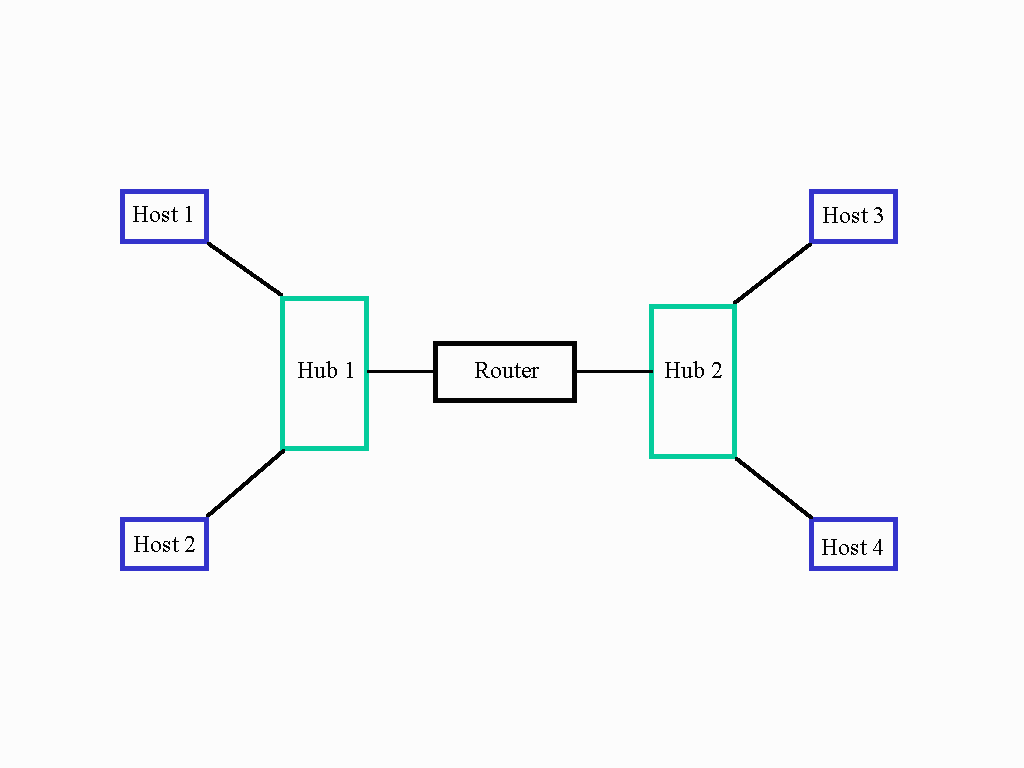
The lines that once separated the three network types are becoming less and less clear. For example, cable companies are now starting to carry data via cable modems. This new capability is costly because it requires the redesigning of the entire cable network to carry full duplex traffic. And Telephone companies are also racing to provide data service as well as their usual voice service. ISDN (Integrated Services Digital Network) is evidence of the telephone companies' attempts to offer higher bandwidth and more reliable data communication than possible with analog. Digital video service is not yet in wide use, but with the popularity of the Internet, it looks to be popular in the near future. Designing networks that offer all three type of traffic is a monumental challenge for network engineers. The rules for designing networks in the past do not apply anymore with customers demanding more bandwidth, QoS (Quality of Service), and higher utilization while expecting the network to handle voice, video, and data. There are many technologies for carrying this digital multi-media traffic, but we will only look at two of these in this paper, ATM (Asynchronous Transfer Mode) and Fast Ethernet (100BaseT). Both of these are positioned to be significant players in the future of information networks but each is driving to out perform the other, and this paper will look at that race and its consequences.

Figure 1. Example of Standard Ethernet.
This simple example shows how four computers might be connected, creating a network. Computers 1 and 2 are connected via a hub, which simply takes information from one of two connected computers and broadcasts it within the connections to the hub (Computers 3 and 4 are also connected in this same manner). In this example there are only two adjoining computers so the broadcast is really only sent to one computer but in much more complex networks several more computers would be connected to just one hub. The hub simply acts as an intermediary between computers that communicate frequently. What happens when computers are not connected to the same hub but need to communicate? This is where the second intermediary, the router, plays its role. In our example, this is illustrated by computer 1 needing to communicate with computer 3 or computer 4 (the same illustration is made with computer 2 as well). When computer one places its data out onto the network, the router recognizes that the destination is an adjoining network and therefore transfers the data. This simple example illustrates the basics of Ethernet and the basis under which Fast Ethernet evolved.
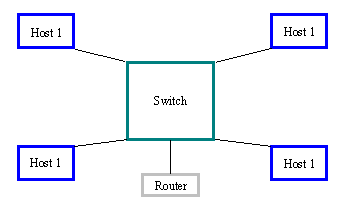
Figure 2. Example of Switched Ethernet
Switched Ethernet is a relatively new concept that simply takes the simple network design and adds the benefits of switching to it. The simple network can be rightfully termed "dumb" because traffic is just basically broadcast to adjoining computers resulting in poor use of the network. Switched Ethernet adds switches to the basic network so the utilization of each resource is increased. A switch is basically a fancy hub where the frames are "switched" to the appropriate destination instead of broadcasting to everybody. A switch actually knows where the information is going and where the destination is, which means a link between the sender and the receiver is set up by the switch. This means a switch enhances the flow of network traffic and increases utilization. It is important to point out here that Switched Ethernet does not run faster than typical Ethernet. Both of these networks are bound to the line speed of 10Mbps but Switched Ethernet utilizes this line speed much better than Ethernet. The 10Mbps boundary is an obstacle for Ethernet and Switched Ethernet, which is why a hurdle was made to 100BaseT Fast Ethernet.
Fast Ethernet is virtually identical to 10BaseT Ethernet. The same protocols and methods of transport are used in both versions, but the line bandwidth is what separates them. Fast Ethernet increased bandwidth remedies the bottlenecks found in standard 10BaseT due to a lack of bandwidth. As with Switched Ethernet, switches can be added to Fast Ethernet to created Switched Fast Ethernet to allow better utilization of the network.
3. ATM (Asynchronous Transfer Mode)

Figure 3. Ethernet Packet Description.
Fast Ethernet uses the same standards as Ethernet, which has a 26 byte header that specifies destination address and source address along with other overhead information. With Ethernet the packet is broadcast onto the network via the hub and each computer looks as the packet header for the destination address. If the destination address matches the address of one of computers connected to the hub then it will be picked up by that computer. Once the destination computer picks up this packet, 46-1500 bytes will have been received which is the payload of an Ethernet Packet.
A Fast Ethernet network is limited in several respects. The bandwidth of the network is at the mercy of every user on the network. If one sender requires the use of all the bandwidth allocated on the network then when other users place information onto the network it is buffered until it can be sent. This is a huge network management concern because if too much information is placed onto the network at once the network could crash. What this basically says is, shared-media LANs, such as Fast Ethernet, have characteristics that cause the average bandwidth available to each user to decline with each additional user. This is the main concern when discussing the use of Fast Ethernet for multimedia applications because these applications require such a large portion of the bandwidth on the network. This type of architecture is what is plaguing Ethernet when it comes to using such applications as desktop videoconferencing.
Figure 4 Bandwidth vs. Number of Users.
4.2. ATM
ATM traffic travels in cells not in packets. These cells are 53 bytes, which was discussed above, with a header of only 5 bytes. This means that the payload is only 48 bytes. This cell format is illustrated below:

Figure 5. ATM Cell Description.
The payload is small but this is part of the design. In Fast Ethernet the packet size is largely based on the information that is being sent. For example, voice and video applications in Fast Ethernet create large packets that are then sent over the network. These large packets can cause congestion in the network or in the buffers of the network. ATM cells are fixed length, which means they are always 53 bytes wide and so the problems associated with the variable length Ethernet packets are avoided in ATM. The model shown below describes ATM architecture:
.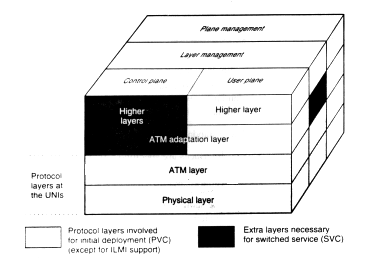
Figure 6. ATM Layer Architecture
The ATM standard consists of three areas of functionality that are shown in the model:
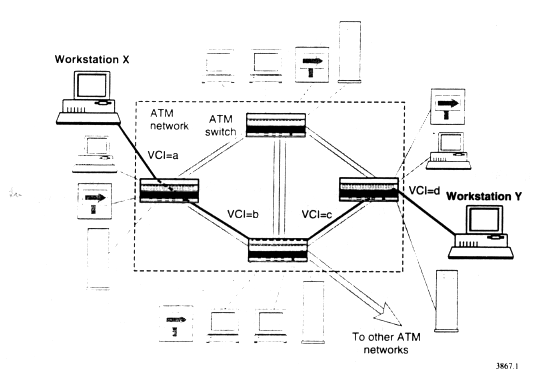
Figure7 SVC Network Model.
The purpose of the ATM layer is to provide a common set of services to support higher layer protocol functions such as data, voice, or video applications. These services include multiplexing multiple data streams and switching data over a network to the correct destination. Virtual paths are set up throughout the ATM network, which provide a guaranteed amount of bandwidth requested by the application. If this request cannot be guaranteed by the network then the request is refused. This type of virtual path is called a SVC (Switched Virtual Path). It is set up only for the duration of each transmission session. The following figure illustrates a network with SVC:
This function is apart of the traffic management scheme that ATM uses.
ATM traffic management has many service categories that have been defined
by the ATM Forum. The following tables give a description of these
categories:
| Constant Bit Rate (CBR) | Variable Bit Rate, Real Time (VBR-RT) |
| - traffic pattern is deterministic | - traffic pattern is known and burst |
| - cannot tolerate jitter or delay | - minimal cell delay variation |
| - examples, voice traffic, circuit emulation, video | - example, compressed video |
| Variable Bit Rate, Non-Real Time (VBR-NRT) | Available Bit Rate (ABR) |
| Traffic pattern is known and burst | Burst traffic |
| Can tolerate more delay than VBR-RT, but delay should still be bounded. | Dynamic |
| Can tolerate any cell delay variation | Delay tolerant |
| Example, frame relay | Example, TCP/IP LAN traffic |
| Unspecified Bit Rate (UBR) |
| - No guaranteed quality of service |
| - Relies on higher level protocols to provide flow control |
| - Example, TCP/IP LAN traffic |
The picture below shows probable service categories for ATM applications.
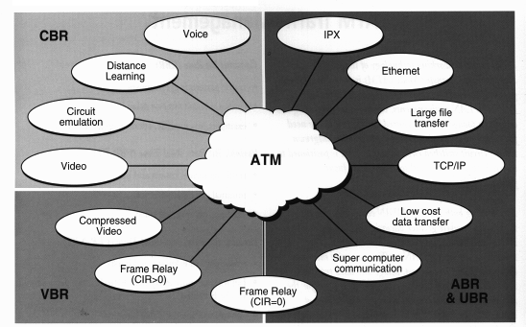
Figure 8 ATM Applications.
The purpose of these traffic management schemes is to balance high quality service with maximum network utilization.
Fast Ethernet has made huge progress over 10BaseT Ethernet in delivering these voice packets to the destination quickly. This improvement is due primarily to the increased bandwidth of the lines. For a customer who just upgraded from 10BaseT this would provide good voice channels because the network utilization would be quite low. As the traffic on the network increases, however, voice communication would become degraded because packets would begin to be stored in buffers until the network allows for their transmission. Because of the continuous bit rate associated with voice communication, the Fast Ethernet packet would be large in comparison with an ATM cell. In the case of lost or damaged packets/cells, a loss for delayed Fast Ethernet will have a significant impact on voice communication performance compared to a small ATM cell. For this reason, Fast Ethernet is not a good solution for good communication on a congested network.
The structure of ATM lends itself well to the implementation of voice traffic over the network. ATM will set up a SVC (Switched Virtual Channel), using the AAL1 protocol, throughout the network at the initiation of a session and eliminate this SVC at the end of the session.
The SVC specifies a path and allocated bandwidth through the network. This means that a voice session will have all of its packets delivered through the same path and in a timely fashion. If the network is too congested to guarantee the above criteria then the request will be denied. The SVC is very similar to the physical switching done by the telephone network and is therefore very adept to carry good quality voice traffic.
As in voice, the structure of ATM lends itself well to the implementation of video traffic over the network. The SVC that is set up by the network will assure a constant stream that is necessary for good quality. The SVC system does not mean that there is no buffering in the ATM network. There is buffering but it is not on the network, like in Fast Ethernet, but is at the card level where network performance is not sacrificed. This does not mean network management is not an issue with ATM because good network management always connects computers together (in the same domain) that are frequent communicators, but it is not such a crucial element to allow for quality video as it is in Fast Ethernet.
ATM networks still set up a SVC for data traffic but this is not a necessity for data traffic since real time transmission is not crucial.
ATM equipment is not too much more expensive, except for the adapters, but the cost in implementing this equipment is very high. The current network basically has to be thrown out to make room for an entire ATM network. This means the current Ethernet equipment would be rendered obsolete and placed out of service. This is a pricey task especially for those who have enormous Ethernet networks already setup. It is not entirely true that there is no ease of migration for ATM. In view of the hardship involved in changing to an ATM network most developers of ATM equipment have come out with Ethernet switches that will allow an Ethernet network to be changed into an ATM network; an Ethernet- to-ATM switch.
This switch would allow companies to slowly change to ATM, but we have
already discussed the standards issues that plague this market right now.
Which company do you buy your ATM equipment through because if you buy
from one, you might not be able to integrate that equipment with equipment
from another company. It is a very risky move, and there are too
many considerations to be taken into account for such a move which is why
ATM will not become the LAN of choice for some time to come. The
chart below illustrates the cost differences in the adapters for Fast Ethernet
and ATM as well as a few others.
| 100BaseT | ATM | |
| Speed | 100 Mbps | 155 Mbps |
| Cost | < $295 | ~ $1,300 |
The authors of this paper thank Dr. M. S. Shiva kumar, Head, Department of Computer Science & Engineering of The National Institute of Engineering, Mysore for his valuable guidance in writing this paper.